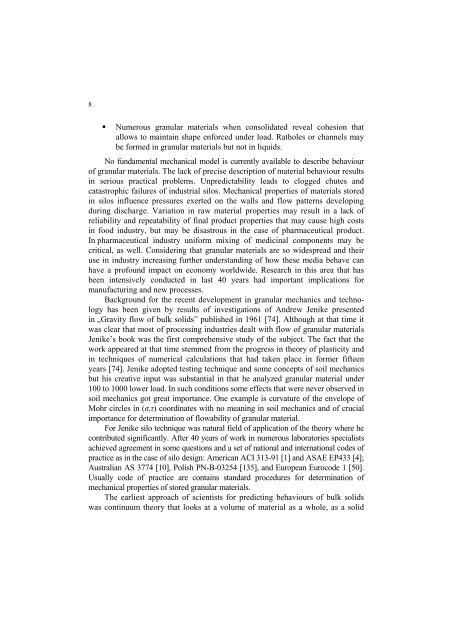Strona 2_redak - Instytut Agrofizyki im. Bohdana DobrzaÅskiego ...
Strona 2_redak - Instytut Agrofizyki im. Bohdana DobrzaÅskiego ...
Strona 2_redak - Instytut Agrofizyki im. Bohdana DobrzaÅskiego ...
You also want an ePaper? Increase the reach of your titles
YUMPU automatically turns print PDFs into web optimized ePapers that Google loves.
8<br />
<br />
Numerous granular materials when consolidated reveal cohesion that<br />
allows to maintain shape enforced under load. Ratholes or channels may<br />
be formed in granular materials but not in liquids.<br />
No fundamental mechanical model is currently available to describe behaviour<br />
of granular materials. The lack of precise description of material behaviour results<br />
in serious practical problems. Unpredictability leads to clogged chutes and<br />
catastrophic failures of industrial silos. Mechanical properties of materials stored<br />
in silos influence pressures exerted on the walls and flow patterns developing<br />
during discharge. Variation in raw material properties may result in a lack of<br />
reliability and repeatability of final product properties that may cause high costs<br />
in food industry, but may be disastrous in the case of pharmaceutical product.<br />
In pharmaceutical industry uniform mixing of medicinal components may be<br />
critical, as well. Considering that granular materials are so widespread and their<br />
use in industry increasing further understanding of how these media behave can<br />
have a profound <strong>im</strong>pact on economy worldwide. Research in this area that has<br />
been intensively conducted in last 40 years had <strong>im</strong>portant <strong>im</strong>plications for<br />
manufacturing and new processes.<br />
Background for the recent development in granular mechanics and technology<br />
has been given by results of investigations of Andrew Jenike presented<br />
in „Gravity flow of bulk solids” published in 1961 [74]. Although at that t<strong>im</strong>e it<br />
was clear that most of processing industries dealt with flow of granular materials<br />
Jenike’s book was the first comprehensive study of the subject. The fact that the<br />
work appeared at that t<strong>im</strong>e stemmed from the progress in theory of plasticity and<br />
in techniques of numerical calculations that had taken place in former fifteen<br />
years [74]. Jenike adopted testing technique and some concepts of soil mechanics<br />
but his creative input was substantial in that he analyzed granular material under<br />
100 to 1000 lower load. In such conditions some effects that were never observed in<br />
soil mechanics got great <strong>im</strong>portance. One example is curvature of the envelope of<br />
Mohr circles in (σ,τ) coordinates with no meaning in soil mechanics and of crucial<br />
<strong>im</strong>portance for determination of flowability of granular material.<br />
For Jenike silo technique was natural field of application of the theory where he<br />
contributed significantly. After 40 years of work in numerous laboratories specialists<br />
achieved agreement in some questions and a set of national and international codes of<br />
practice as in the case of silo design: American ACI 313-91 [1] and ASAE EP433 [4];<br />
Australian AS 3774 [10], Polish PN-B-03254 [135], and European Eurocode 1 [50].<br />
Usually code of practice are contains standard procedures for determination of<br />
mechanical properties of stored granular materials.<br />
The earliest approach of scientists for predicting behaviours of bulk solids<br />
was continuum theory that looks at a volume of material as a whole, as a solid
















